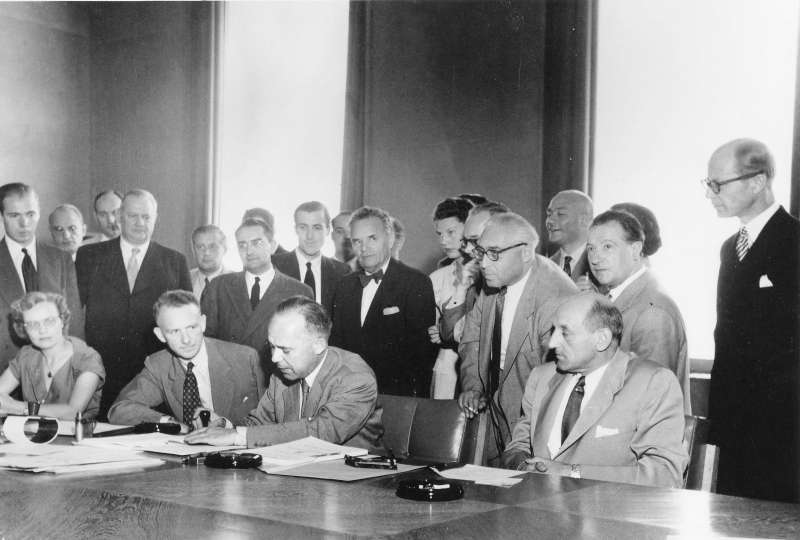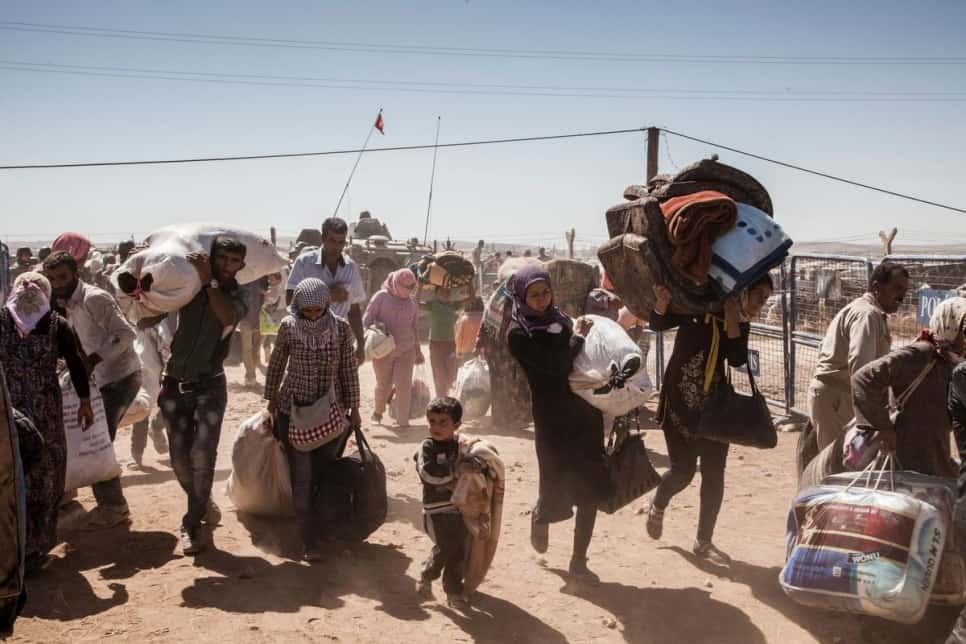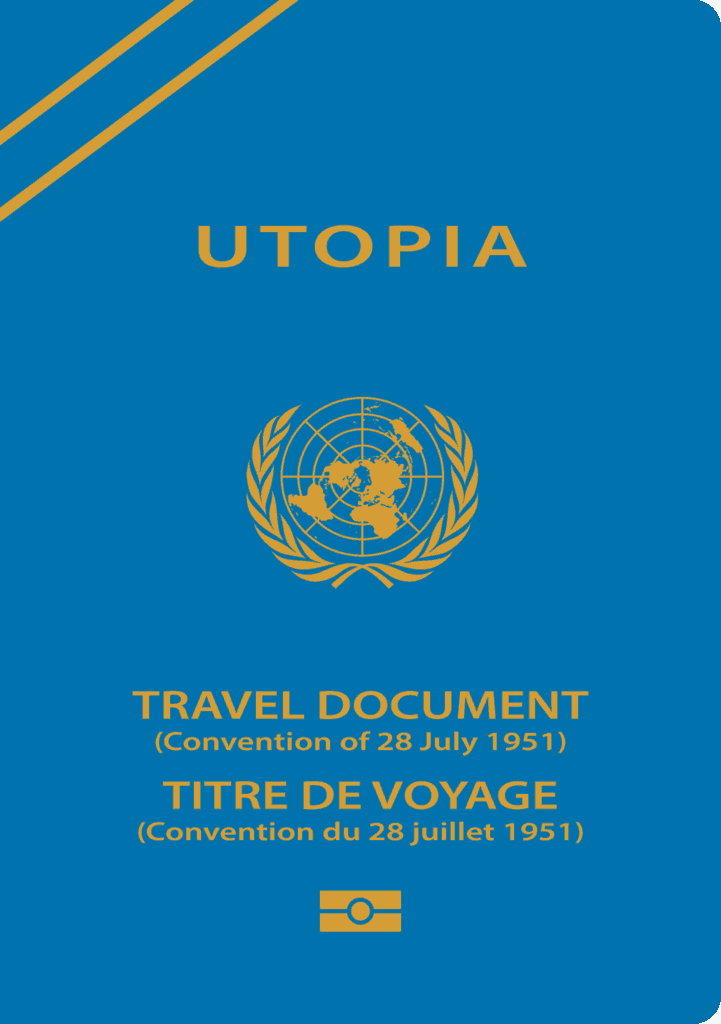Most of the time, when you want to cross an international border, you need to present a passport. And passports, as most people know, are issued by governments to its citizens. But what happens to refugees unable to obtain a passport from the government of their country of origin? Refugees are persons fleeing persecution, conflict or violence in their country of origin, and therefore cannot, or cannot reasonably, approach the authorities of their countries of origin to obtain a passport, as this might put them at serious risk of harm. For a refugee, being in contact with the country he or she fled from might be life-threatening, or put his or her family or relatives at risk. Or what if the person is “stateless” – in other words, a person who is not recognized as a citizens of any State and therefore has no State from which to request a passport?
“Refugees and stateless persons very often do not have access to the national passports that most of us take for granted,” explained Caroline Dulin Brass, a Senior Legal Officer with the United Nations High Commissioner for Refugees (UNHCR). “For these reasons, refugees and stateless persons rely on their host State – the State that they are staying in – for travel documents. The 1951 Refugee Convention and the 1954 Statelessness Convention recognized this dilemma, and gave refugees and stateless persons the right to a Convention Travel Document (named after the Conventions that granted this right) in their State of lawful stay.”

In spite of these obligations, only one out of five refugees worldwide have access to Convention Travel Documents which are issued in accordance with international standards. “As many as 41% of the world’s refugees are believed to have no access at all to travel documents, meaning that they have no legal means of traveling abroad, even for short visits to visit their family members, study, or obtain medical care which is not available in their host State. This is also important as the possibility of travelling abroad can help them find durable solutions, work and education, and to maintain normal contact with family members who are often spread across different countries,” Dulin Brass said.
In short, as the right to a travel document supports the right of refugees and stateless persons to travel, and to live meaningful, fulfilling and stable lives, achieving progress on these issues is therefore aligned with UNHCR’s mandate to promote the rights of refugees and stateless persons, and with ICAO’s mandate to support the development of air transport as a means for improving human wellbeing.
On this point, UNHCR’s Executive Committee, after almost six months of negotiations, recently adopted its first Conclusion on Machine-Readable Travel Documents (MRTDs) for Refugees and Stateless Persons. The Conclusion refers specifically to the need for Convention Travel Documents to refugees and stateless persons be issued in line with the standards adopted by ICAO. It also refers to the benefits associated with the increased security features provided by MRTDs.
“Machine-Readable Convention Travel Documents (MRCTDs) should facilitate international travel of refugees and stateless persons. MRCTDs issued in line with Doc 9303 increase security and mutual trust among States in their respective documents,” explained Jitendra Thaker, a Technical Officer with ICAO’s Facilitation section, referring to the manual that sets forth the relevant technical standards. “An MRCTD is a more secure travel document. As such, MRCTDs may facilitate visa procedures. Moreover, they offer will offer refugees and stateless persons the same access to modern, efficient facilities at border control points as holders of ICAO compliant passports.”
The Conclusion, in its operative clauses, calls upon States parties to the 1951 Refugee Convention and 1954 Statelessness Convention to take “all the necessary legislative, administrative and technical measures” to introduce MRCTDs for refugees and stateless persons, and invites the sharing of good practices, such as the “simplification and facilitation of procedures and other administrative requirements, as well as of machine-readable travel document production systems.” It also includes a commitment to further international solidarity and equitable responsibility- and burden-sharing to support States, and the provision of capacity-building and technical support, as appropriate, in collaboration with ICAO and UNHCR.
“We at UNHCR are very pleased to have this Conclusion, as it’s the first conclusion on travel documents for the last 20 years, and it gives us additional support and weight in our advocacy work towards States,” Dulin Brass declared. She also noted that the Conclusion was the first to mention travel documents for stateless persons at par with refugees, representing “a large step forward for our work on the rights of stateless persons.”

Stateless persons have the same right to Convention Travel Documents as refugees. However, in practice, UNHCR has noted that only a minority of the world’s stateless persons have access to such documents. For example, while 73 States now issue ICAO-compliant Convention Travel Documents to refugees, only 30 States issue such documents to stateless persons. Although UNHCR has seen the number of States issuing such documents to refugees double over the last five years, the same progress has necessarily not been made for stateless persons. “There is a real risk of stateless persons being left behind and, in reality, many stateless persons are prevented from travelling abroad through legal means,” Dulin Brass said. “In UNHCR’s experience, this has led to stateless persons trying to cross international borders illegally and being detained, in some cases over longer periods of time, or being subject to abuse and exploitation at the hands of human traffickers and smuggling networks.”
The Conclusion makes crucial contributions to the political momentum towards addressing these issues, in addition to providing a platform for practical progress in terms of the implementation of these documents. In regard to the latter, as compliant travel documents, MRTCDs are included in ICAO’s comprehensive Traveler Identification Programme (TRIP) Strategy. This Strategy provides pragmatic guidance to States deploying ICAO travel documents and the technology associated with the electronic exchange of information they hold. “Through ICAO’s Technical Cooperation Bureau, Member States planning to issue MRTCDs will have the opportunity to request assistance or technical support of the TRIP Technical Advisory Group and the Facilitation Section in order to comply with the specifications of Doc 9303,” Thaker said. “Other opportunities will include the exchange of best practice and the development of partnerships at the annual and regional TRIP Symposia.”

UNHCR is relying on its longstanding collaboration with ICAO, as the owner of the relevant standards, for technical expertise and seek to jointly provide support to States. This includes the provision of technical guidance, such as the joint UNHCR/ICAO Guide on Issuing Machine-Readable Convention Travel Documents, the latest version of which was published in February 2017. In other cases, it can be direct dialogue and advice to States by the UNHCR office in a country, in particular during the transition to MRCTD. The UNHCR has also, in exceptional cases, offered financial support to States to facilitate the transition to Machine Readable Convention Travel Documents, for example by providing additional funding for software or printers.
The UNHCR has many examples of how travel documents can make a very real and tangible difference to the individual holding it. For a few, the travel document might make the difference between life and death, as is the case for refugees who are not able to travel abroad for life-saving medical treatment. For others, it means the possibility of finally reuniting with their spouses and children who have found safety in other parts of the world. For others again, such as young students stranded in refugee camps with limited prospects of higher education or work, it can mean the opportunity to travel abroad, attend a university, and learn a profession. And, more extraordinary, for a handful of refugees, it meant being able to travel to the Olympic Games in Rio de Janerio and be part of the world’s first refugee team.
These are just but a few examples, but they crucially underline that travel documents are not just pieces of paper. These examples underscore that the cooperation between the UNHCR and ICAO towards enhancing the availability of these crucial documents can in fact change the course of refugees’ and stateless persons’ lives.
